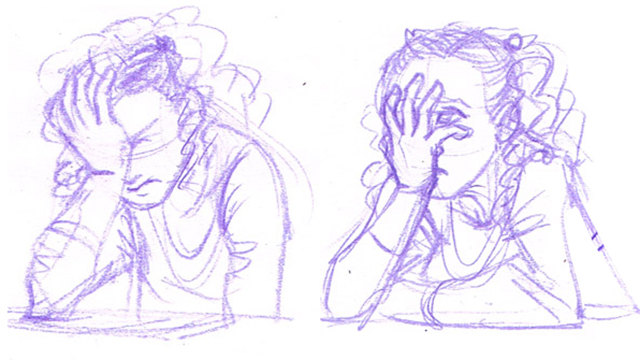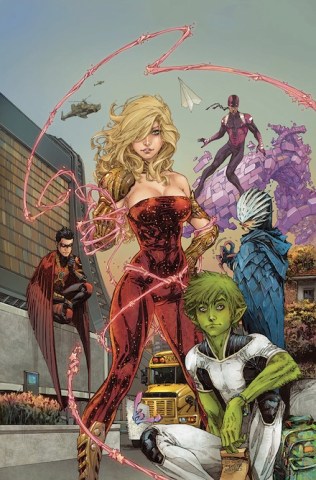An Illustrated Guide to Issues of Harassment, Representation, And Media Criticism
Trolls get banned, JSYK.

Karine Charlebois (@Kanthara) published the following piece, originally titled “Criticism, Rape Threats, Double Standards, And Other Issues,” on her blog Less Tits N’ Ass, More Kickin’ Ass back in April. Unfortunately, the issues of equal representation and harassment of those who speak out in support of it haven’t gone away since then, so the essay remains relevant. Given the recent wave of harassment occurring in the video game sphere, which we posted about earlier today, we felt it’d be a good time to share the piece (with permission). You can read more of Charlebois’ writings on Less Tits N’ Ass and her personal blog.
I wish this didn’t have to be said again. I know many people have spoken about this, written about this, and yet the issue keeps coming back again and again.
This blog is full of criticism about the way women get portrayed in comics, and I knew the risks of writing it included getting attacked for my opinions, not on the opinions themselves, but on my person. And yes, it has happened. I have been called a feminazi. I have been called a crazy pedantic cunt. I have received threats, but far fewer of those than other women have. How did I react to these posts? Mostly by focusing on the positive feedback, concentrating on those divergent opinions that talk about the content of my posts, and by not feeding the trolls.
Not feeding the trolls. Because that’s what we’re taught to do on the interwebz, right? Well, there’s a difference between trolls and threats of actual physical violence and abuse. And this is definitely something that should be stopped by calling it out and reporting it.
Duck into the comments of most pieces that take a critical approach to how women are portrayed in media, and you’ll see some things that aren’t pretty. [Editorial note: This is a good time to mention our own comment policy. Read it. Know it. Live it.] I’ve pulled some examples from a post Janelle Asselin made about the harassment she was subjected to following her critical assessment of the cover of Teen Titans #1. What I saw made me go through a series of emotions that I have trouble putting into words.


Someone tell me how making a cover appealing to a wider audience means that it should appeal only to women? This is the fallacy of things being taken away from men.


Right. It’s never happened to you so therefore it’s the other girl’s fault for “being pretty”. Also, because she’s threatened with rape she’s on the defensive and she’s told she should just calm down and be reasonable.


This guy spent hours on the site saying “But don’t you understand me? I’m saying it’s not all men, I’m playing devil’s advocate, you paint us all with the same brush” and also “Educate me on how to be a feminist ally.” And when people told him the basics of “stop talking, start listening, stop playing devil’s advocate, we know it’s not all men,” he turned around and started telling everyone they were wrong.




Remember that post I made about “sexy, sexism and sexualisation”? There was a follow-up question about sexual context, as well. Magic Mike is about a sexual context, so yes, we are ogling men being sexy because that is what the context of this movie is. And that follow-up thing about an obese geriatric amputee is just plain stupid.

First of all, who says Teen Titans caters to adolescent boys? Second, who says the cover has to cater to women only? Third, realism here is about the fact that these are supposed to be teens. Fourth, this is the root of the subject of the post I wanted to write in the first place, although I got really distracted by the rest of the feminism arguments that happened all over that comment thread.
Getting back to the Magic Mike comment, the example was given to show that women objectify men in a sexual manner the same way men objectify women. The example is a bad one because of, as I stated above, the context of the movie being sexual in nature. The cover that was being criticised is not. A fairer comparison would have been that Thor scene where Chris Hemsworth is shirtless and putting on jeans. It was there for pure titillation, and it did its job very well. But that scene, presenting a man as, well, yummy, is far, far less frequent than the same kind of scene presenting a woman. Then again, we’re still not in a completely fair comparison, because the cover wasn’t about showing us how hot the character is, but showing the group of heroes.
The whole catering thing is an issue because—okay. Let me put it this way.
I am a white, straight cis-female who’s thin. Therefore, I have privilege. I see characters who look like me in a lot of the media I consume. This is why I didn’t notice there was a problem in representation for the longest time. Oh, as a kid I’d notice there were only two female characters in G.I. Joe, and if I didn’t call Lady Jane fast enough I’d have to play the Baroness; I made up a female Transformer character in my own stories before the show added them in a later season because that was really missing. I’d notice that shows with teams were often a bunch of guys and a token female. For the longest time I thought Tweety Bird was a girl and was really disappointed to find out that wasn’t true. But the females that were on the shows were white, pretty, thin, and basically looked similar enough to me for me to identify with them.
Anyone who knows me knows how much I love Gargoyles. I love this property so much because it has so many good things in it, but it also has problems, and it’s because I love it so much that I’m choosing it as an example of my wider scale criticism. Gargoyles are humanoid, grotesque creatures with wings and tails. They adorn old castles and churches and, in this story, break out of their stone shells to live at night. Their shapes and colours are as varied as anything, even moreso than humans are, especially where size is concerned. There’s a tall, V-torsoed hero who represents the idealized figure of heroics. The barrel-chested geriatric member of the group is a warrior past his prime. Then you have three young ones, from the small to the athletically lean to the larger one. And that’s just the main cast. All male. Much variance.

And then you have the one (token) female. Thin. Traditionally beautiful. Actually, every other female gargoyle was built on the same model. To prove my point, here’s a sampling.

It took a little over 10 years before we got new Gargoyles in the comics, and thankfully the mold was broken with Constance and Sacrifice. But the point remains that the character designers and art director on the show did not take risks when it came to designing female characters, because anything out of the above template is considered undesirable in most media.
Therefore, the message we send everyone is that while male heroes can come in all shapes and sizes, females only come in one. And if you, as a consumer of said media, don’t fit the template, well, sucks to be you. Suck to be you because you don’t see yourself anywhere, and sucks to be you because everyone becomes blind to the existence (and acceptability) of varying body types like yours. What happens when people add in a diverse female character? It risks becoming a token, recognised only as its difference from the established norm and not as a person. Not the way male characters who are older or younger, or chubbier or less stacked, are seen as different people. And I haven’t even addressed how race of either gender comes with typecasting and tokenism.
Getting back to female characters, we need variety in design that allows for story-relevant design choices, like drawing a teenager like a teenager, not like the adults who play teenagers on TV, for instance.
The big problem is that in comics, there’s also a template, and it also needs to be broken. Unfortunately, post-New 52 got rid of variety, Amanda Waller being a prime example. In truth, the problem lies in having trouble accepting things we’re not used to seeing. The more variety in design we’re exposed to, the less fringe or token that variety will seem, the more acceptable it will become in the audience’s eyes, and the more everyone will find people they recognise in in the media they consume. But as much as it has to come from creators to create these kinds of characters, it has to come from the audience to accept these designs, to call out when things could be done better, and to see criticism as a way to question the validity of the status quo and to make things better, not as an attack on the things we like and a call to destroy them. And if we could just keep the physical and sexual violence threats out of the equation, we would all be better off.
Karine Charlebois is a Quebec-based storyboard artist whose credits range from animated shows on PBS like Arthur and Sagwa the Chinese Siamese Cat to animated sitcoms like Fred’s Head and Pérusse Cité. She’s also worked on the Gargoyles and Gargoyles: Bad Guys comics printed by SLG, under Disney license. Karine is married and a mother of two exceedingly bright boys. When not dealing with storyboard deadlines while figuring out how to make the family schedule work, she can be seen fighting for the better representation of women in comics.
A reminder to everyone in the comments section: please read and respect The Mary Sue’s official comment policy, as we do enforce it and will delete comments or ban users accordingly.
Are you following The Mary Sue on Twitter, Facebook, Tumblr, Pinterest, & Google +?
Have a tip we should know? [email protected]
